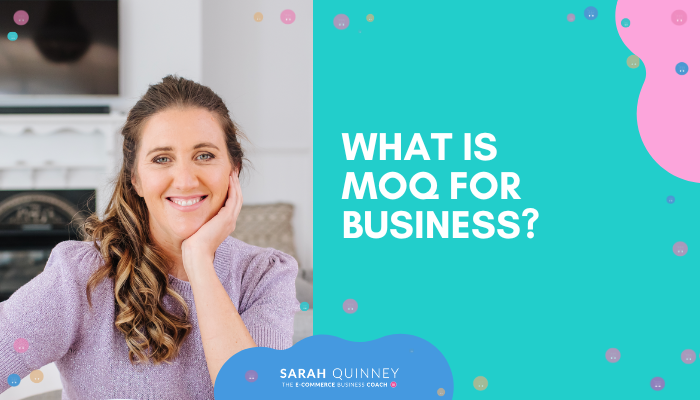
What is MOQ for Business?
If you’re here, you have probably found yourself asking “what is MOQ? Why does it matter for my business?” You’ve come to the right place!
MOQ stands for minimum order quantity, and it refers to the smallest amount of product a supplier will allow one of their buyers to order. When suppliers set an MOQ it allows them to maintain a profit margin, and it allows you as the buyer to ensure that they have the amount of stock that you need and/or agreed upon.
Minimum order quantities can change as the market changes. Some of the reasons it may change include pricing shifts in the top of the supply chain or changes ind emand. Because of market volatility, you shouldn’t expect MOQ to stay exactly the same on every order you place.
Advantages and Disadvantages of Minimum Order Quantities
Advantages
There are many reasons that suppliers choose to use MOQs in their business model. Some of the most common include:
- Controlled profit returning to the business (and knowing what sort of profit to expect)
- Building trust with buyers
- Creating long-lasting supplier and buyer relationships
- Reducing costs in areas such as storage, shipping, and labour
Disadvantages
There are also some disadvantages of using MOQ including:
- Minimums may be too high for new or smaller businesses
- Buyers may choose to work with MOQ-free sellers
- MOQs set for stock purposes may mean that you can’t fulfil stock requests for all buyers
High vs. low MOQ
One way that MOQ can affect businesses is through inventory. High and low MOQs have different impacts on how inventory is managed.
High MOQ
Suppliers with high MOQ need to keep a large inventory in order to fulfil orders quickly. With this method, there is a low risk of running out of inventory, but a high risk of products no longer being in demand. These sellers could wind up with overstock filling their shelves.
When this happens, the extra stock can take up a lot of resources in time, effort, and money. On the other hand, it does free up administrative costs because ordering is less frequent and they may get bulk discounts on components.
Low MOQ
Suppliers with low MOQ will typically have smaller inventories because they have smaller orders. They will most likely have a higher inventory turnover rate.
With this method, there could be increased pressure on the sales team to find more customers and drive more sales. While they won’t risk changes in demand for the product, they will risk running out of inventory.
Suppliers: Here’s how to calculate MOQ
According to ShipBob, there are a few different ways to determine MOQ including the level of demand, the break-even point, and the holding costs.
Demand
To determine the demand for a product, look at the season, niche, competition, type of product, and other characteristics that may or may not create demand. This can help you determine how much of the product you may need for a certain period of time. To be safe and ensure that you can fulfill all orders, it’s a good idea to have a bit of extra inventory (often referred to as safety stock).
Break-even point
Determining the break-even point is the second step in determining MOQ. The break-even point refers to the lowest price that you can charge per unit and still recoup a profit. It should not be so low that you can’t make any profit. But, volume discounts are often expected from buyers when purchasing through a supplier.
Holding costs
Finally, there are costs associated with the storage of each unit before a sale. These are referred to as holding costs and they vary depending on product size, length of time stored, refrigeration, and more. In order to make the most profit products shouldn’t be kept in inventory for too long. It is important to take holding costs into account when determining MOQ. If costs are higher, you may want to increase the MOQ in order to make the holding worth your while.
Buyers: Here’s how to work with a supplier to find the right MOQ agreement
To find the right supplier for you, first get to know your industry. Research your niche and learn the ins and outs of the supply chain you will be entering. Because there is not a standard formula for calculating MOQ, make sure to shop around to find the best price for your business.
If you are wanting to negotiate with a supplier to get a lower MOQ agreement on your orders, it is important that you begin the conversation on your first order. When you are already locked into an MOQ agreement it can be much harder to restructure.
Additionally, many suppliers often have lower MOQ agreements when you agree to pay some of the price of the inventory upfront. Usually, this requires payment of around half of the order price.
Finally, if these options don’t work with your supplier try to negotiate a slightly higher price for a smaller MOQ. This can help offset the cost for the supplier of selling you less inventory.
The biggest key to negotiating with your supplier is to create a strong relationship with them. The stronger the business partnership, the easier it will be for you to communicate your business needs.
What is MOQ for direct-to-consumer business?
It’s not just suppliers who need to consider MOQ for their business. As a direct-to-consumer business, you also need to consider the lowest quantity possible to still generate profit. This is why some things are often sold in 2-packs or other groupings. Take a look at the costs of holding inventory, shipping, and labour to decide your profit margin and MOQ.
MOQ is very important to suppliers, buyers, and supply chains as a whole. Take a look at your business model and find what MOQs work for you.
Ready to scale your online store?
The E-Commerce Women In Business Mastermind – your exclusive e-commerce coaching and e-commerce digital marketing mentorship for women looking to Grow and Scale your online store. Click here to learn more
Yours in success,
Sarah x

